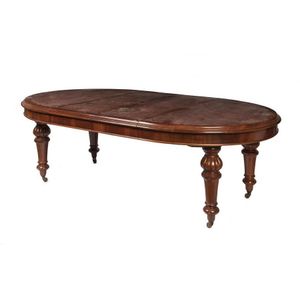19th Century Mahogany Extension Dining Table with Brass Castors
You must be a subscriber, and be logged in to view price and dealer details.
Subscribe Now to view actual auction price for this item
When you subscribe, you have the option of setting the currency in which to display prices to $Au, $US, $NZ or Stg.
- Mahogany - Mahogany is a dense, close grained red-coloured timber from the West Indies and Central America. It was first imported into Europe in the the early 18th century and its use continued through the 19th century. It was popular for furniture making because of its strength, the wide boards available, the distinctive grain on some boards, termed flame mahogany and the rich warm colour of the timber when it was polished.. The "flame" was produced where a limb grew out from the trunk of the tree, and this timber was usually sliced into veneers for feature panels on doors, backs and cornices.
Some terms used to describe mahogany relate to the country from which it originally came, such as "Cuban" mahogany, "Honduras" mahogany etc. However unless the wood has been tested the names assigned are more a selling feature, rather than a true indication of the timber's origin. - Castors - Wheels, fitted especially to chair legs, couches, tables and some smaller pieces of furniture, to enable them to be easily moved about. The earliest castors were of brass, with shanks fitting into the base of the leg, and the wheels often made of leather. In the late 18th century, brass 'bucket' or 'cup' castors were introduced, either rounded or square, fitting directly over the end of the leg and held in place with screws. The wheels were generally solid brass. Bucket/cup castors continued in use throughout the 19th century and indeed are still made today. In the later 19th century wheels were sometimes made of wood, china, either white or brown, and sometimes of steel.
This item has been included into following indexes:
Visually similar items

An Australian cedar extension dining table with three leaves, circa 1870, the rectangular top with rounded ends above a plain frieze, raised on bulbous turned legs with ceramic castors, 125 cm wide, x 125 cm deep, 76 cm high, 238 cm long extended

A Tasmanian huon pine boardroom table fitted with four drawers, cross banded in birdseye huon, resting on solid turned houn pine legs, circa 1880, 83 cm high, 295 cm long, 181 cm deep

A mahogany extension dining table with two leaves, circa 1875, 73 cm high, 154 cm wide (extends to 240 cm wide), 133 cm deep

Regency period mahogany and ebony strung stageback sideboard early 19th century, stageback with sliding compartments, 117 cm high, 213 cm long, 79 cm deep
